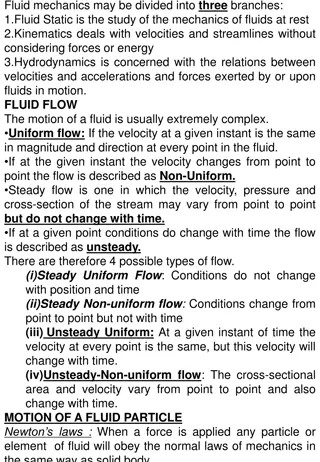
Calculating Fluid Replacement Therapy for Laparotomy and Colon Resection
Understanding the compartments to consider when calculating fluid replacement for a 54-year-old man undergoing laparotomy and colon resection. Factors such as body weight, ongoing losses, blood loss, and urine output are discussed to determine the volume of fluid needed. Learn about signs of preoperative hypovolemia and perioperative fluid management considerations.
Uploaded on | 0 Views
Download Presentation

Please find below an Image/Link to download the presentation.
The content on the website is provided AS IS for your information and personal use only. It may not be sold, licensed, or shared on other websites without obtaining consent from the author. If you encounter any issues during the download, it is possible that the publisher has removed the file from their server.
You are allowed to download the files provided on this website for personal or commercial use, subject to the condition that they are used lawfully. All files are the property of their respective owners.
The content on the website is provided AS IS for your information and personal use only. It may not be sold, licensed, or shared on other websites without obtaining consent from the author.
E N D
Presentation Transcript
Fluid Replacement Therapy Group B
A 54-year old man is undergoing a laparotomy and colon resection for Carcinoma. The anesthesiologist is attempting to calculate the fluid Replacement.
What are the compartment that must be considered when calculating ? The patient body weight is 80 kg, 8 hours fasting with bowel preparation blood loss 500 ml and urine output is 400 ml
The patient body weight is 80 kg Total body water= 48 L (60% of body weight in male) Intracellular water= 32 L (40% of total body weight) Extracellular water= 16 L (20% of total body weight) Interstitial (extravascular)= 12 L (3/4 the extracellular water) Intravascular= 12 L (3/4 the extracellular water) Rich in potassium and fixed anions (protein, phosphate and sulphate) Rich in sodium and chloride and low in potassium
Discuss the volume of fluid that should be replaced?
Perioperative fluid application basically must replace two kinds of losses: (1)losses occurring all the time (mainly urine production and insensible perspiration), possibly to another extent than under normal conditions. (1)losses occurring exclusively during trauma and surgery (mainly blood losses).
The following factors must be taken into account: 1- Maintenance fluid requirements 2- NPO and other deficits: NG suction, bowel prep 3- Third space losses 4- Replacement of blood loss 5- Special additional losses: diarrhea
What are the signs of preoperative hypovolemia ? Supine Hypotensio n Cold dry skin Positive tilt test Tachycardia Low JVP Pale Oliguria Positive tilt test (Increase in heart rate of at least 20 beats/minute and a decrease in systolic blood pressure of at least 20 mmHg or more when the patient assumes the upright position)
How to calculate the fluid replacement in the intraoperative period all of which take into consideration the preoperative fluid deficits?
The patient body weight is 80 kg, 8 hours fasting with bowel preparation blood loss 500 ml and urine output is 400 ml Maintenance: 120 x 8hrs = 960 ml Number of hours NPO x maintenance fluid requirement. 8 x 120 = 960 and ml 1000 ml for bowel prep = 1960 ml Each 1cc of blood loss is replaced by 3 cc of crystalloid solution Fluid deficit (NPO): Blood Loss: 500 ml x 3 = 1500 ml
Urine output: 400 ml of crystalloid Third Space Losses: (4-6 ml/kg/hr possibly), 4 x 80 x 8 = 2560 960 + 1960 + 1500 + 400 + 2560 = 5880 ml Total: Greatest third space losses: *open laparotomies
What is your choice of fluid for replacement Crystalloid vs Colloids? Crystalloi d






















